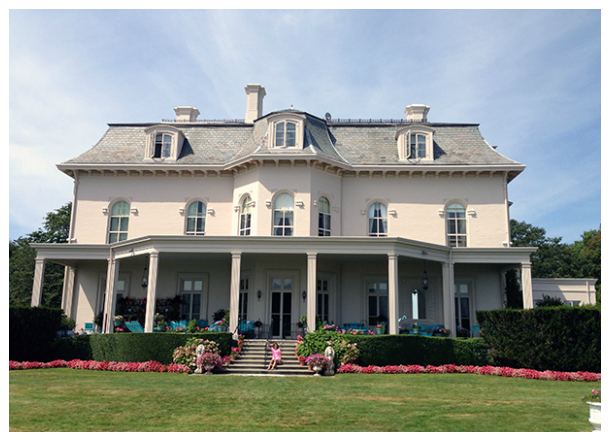 | ||
Similar Beechwood, Bellevue Avenue Historic D, Vanderbilt houses, Marble House, The Elms | ||
Beaulieu, or Beaulieu House, is a historic mansion located on Bellevue Avenue in Newport, Rhode Island, built originally in 1859 by the Peruvian merchant, Federico Barreda, who made his money in the 1850s guano trade. Subsequent owners of Beaulieu have included John Jacob Astor III and Cornelius Vanderbilt III and his wife Grace Vanderbilt, née Grace Graham Wilson.
One of Newport's oldest mansions, Beaulieu was designed for Barreda by New York architect Calvert Vaux, who also designed the bridges in New York's Central Park. In July, 1859, Barreda paid $24,000 for about nine acres on the Bellevue Avenue hill overlooking Narrangansett Bay. He then hired Vaux for a five percent fee on a construction budget of $100,000. Eventually he went over his budget, and spent at least $26,000 more on furnishings and interior decoration. This seasonal “cottage” had sixteen bedrooms, a library, billiard room, a wide surrounding veranda and ample quarters for housekeepers, nannies and cooking staff. It was once described as “the most pretentious and elaborate villa in Newport,” and Barreda’s wife later claimed that she supervised up to eighteen servants there.
Federico Barreda was only twenty-five when sent in 1851 to Baltimore by his brother Felipe, who had secured the contract for the U.S. guano market from the Peruvian government, to oversee distribution of the valuable fertilizer in the United States. Guano riches made the Barredas into wealthy Peruvian oligarchs. In 1853 Federico Barreda married his niece, Matilde Laverrerie Barreda, who was to become the matriarch of the U.S. wing of the Barreda family. The Newport summer residence was built for lavish entertaining that would establish her place in elite U.S. circles. Shortly after the mansion was completed, Barreda was named Peru's minister in Washington. He hired New York City's Delmonico restaurant to cater one of the first social events held in Beaulieu.
The name Beaulieu was given the mansion by the Astors, who were friends of the Barredas and purchased it after the Peruvian suffered financial reverses. Beaulieu neighbored Beechwood, the estate of "The Mrs. Astor," Caroline (or Mrs. William Backhouse Astor, Jr.,) who considered her niece Mrs. William Waldorf Astor, next door at Beaulieu, her only serious social rival. Fortunately for Caroline Astor, William Waldorf Astor, 1st Viscount Astor took his family to England. In 1892, the new-moneyed Vanderbilts spent $11 million to construct Marble House between Beaulieu and Beechwood, and Caroline was then forced to compete with the formidable Alva Vanderbilt for social prominence. Sometime later the Vanderbilts, who reputedly made much of their money manipulating railroad stock, also moved into Beaulieu after William Waldorf Astor agreed to rent his home to Cornelius Vanderbilt III, great-grandson of Cornelius "Commodore" Vanderbilt. The Vanderbilt family would eventually buy the house outright, in 1911.
Currently, the house is in private hands and is not available for public viewing. The Gilded Age pile is owned by Ruth Buchanan, an heiress to the Dow Chemical fortune.
